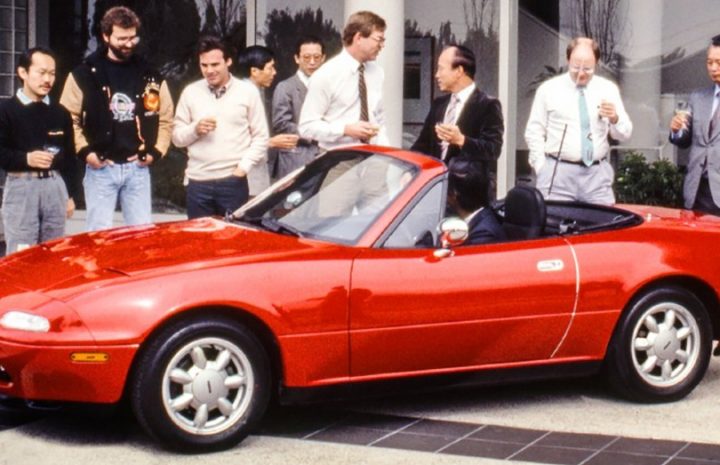One of the creative minds behind the iconic design of the Mazda MX-5 Miata has passed away. Shunji Tanaka died in early December, according to a post on Facebook from a Japanese Miata club. He was 75.
A Co-Architect of the Roadster Revival
It took a team to get the concept of a modern roadster across the finish line. By the 1980s, the roadster was all but relegated to chase scenes in action movies and dreamy sunset coastal drives in romance films.
But Bob Hall, an American product planner, felt the classic design had plenty left in the tank. The former journalist pitched the original idea of a British-style roadster to Mazda executives in the early 1980s. Initially, it was a tough sell to the executives, but Hall and his American team persevered and presented the first clay model of the Miata to Japanese designers.
Toshihiko Hirai, the project’s chief engineer, is widely credited as the “true patriarch” of the MX-5 Miata. Along with engineer Takao Kijima, Hirai is responsible for the Mazda roadster’s athletic, engaging, driver-focused experience.
But it was Tanaka who refined the original design, which he thought was too heavy and “Americanized.” Not one to mince words, he said the California design team must have “eaten too much steak and forgotten the delicacy of Japanese cuisine.”
Instead of “steak,” Tanaka took his design inspiration from Japanese Noh masks, which appear to change their expression depending on the angle from which they’re viewed. “…Many different feelings and wishes are held within the mask, their appearance depending on the light and changing shadows. It is very characteristic of the Japanese and completely different from the western notion of expressing perfection correctly,” he said in an interview for Brian Long’s book “Mazda MX-5 Miata.”
The result is a design that delivers incredible curb appeal and a refined driver-focused interior.
The “Swinging Time Machine”
Originally, the idea for the Miata was a “Swinging Time Machine” that allowed drivers to drop the top and experience an affinity with both the car and nature.
“I also wanted to enclose the rhythms—peace, motion, and silence—which exist in the Japanese heart, into the form of the sports car,” Tanaka said in “Mazda MX-5 Miata.”
“[Tanaka] came from sculpture, and he was the only one who could translate the emotion we induced onto the exterior design of the Miata,” noted Mazda executive Tom Matano. “He and Hirai, the program manager, translated our concept, theme, and nuances to what became the NA [Miata].”
A Champion of the MX-5 Miata to the End
Born in 1945, Tanaka was a sculptor whose storied career at Mazda ended when he moved to Kawasaki, where he redesigned the company’s motorcycle line. He was still active in the Mazda Roadster Club, appearing as a guest of honor at events held in Japan.
”I Have No Regret in My Life”
Those are believed to be Shunji Tanaka’s final words. And given the legacy he left, his sentiment is more than justified. Thanks to his contribution, the iconic Mazda MX-5 Miata will forever be known as the design that revived the roadster. Head down to your local Mazda dealership to drive one for yourself!
This post may contain affiliate links. Meaning a commission is given should you decide to make a purchase through these links, at no cost to you. All products shown are researched and tested to give an accurate review for you.

